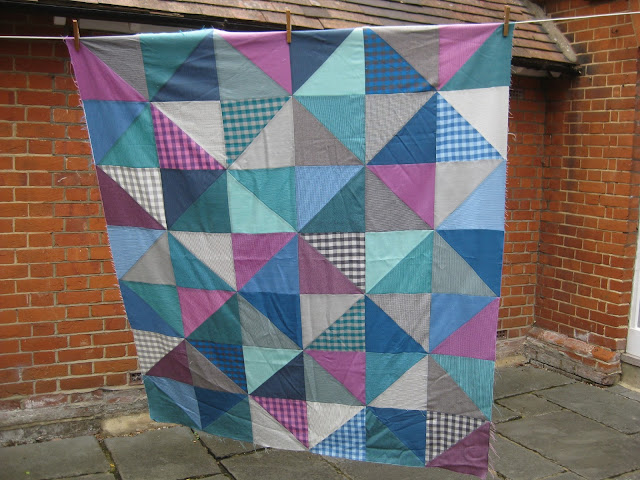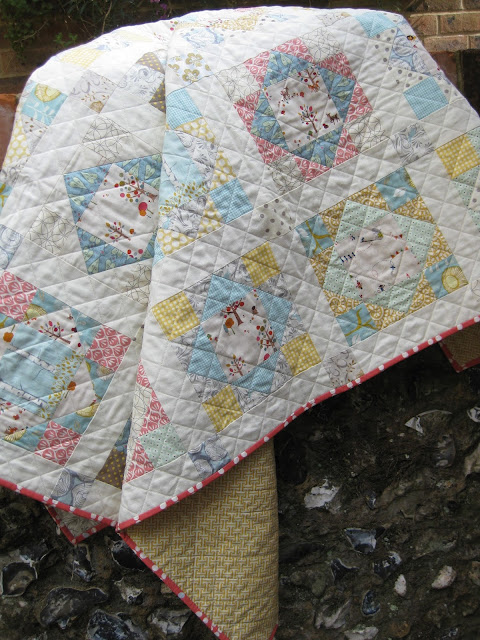Hi everyone! Summer here in the UK seems to have departed so I can't get out into the garden, chilly rain reminiscent of November...
Despite a few nevertheless very enjoyable social engagements (including a graduation and a wedding) and the delivery of our new greenhouse to replace the ancient falling-down one, and much coming and going of family members, I have managed to fit in a little light sewing and finished putting together the two HST tops I mentioned in my last post.
So here they are: one made with large HSTs (trimmed to 9 1/2" square), the other made with 1 1/2" HSTs (finishing 1"), hence little and large, though neither top is especially big.
First, the Vast quilt, though not particularly vast, measuring 54" x 64" (please excuse creases, I forgot to iron in my rush to get a photo before it rained again). The size is determined by the fact that I wanted to use the Layer Cake I already had (Dapper Wovens) and to see how big I could make the quilt with negligible waste.
I really liked the Vast quilt in Jeni Baker's book (here is another version Jeni made and blogged about earlier this year) which was also made by Anna Graham of Noodlehead (see her version here), and I was all fired up to make HSTs because of the talk I was giving on Terrific Triangles. I got maximum yield from the Layer Cake - 42 layers 10" square yielded 42 HSTs 9 1/2" square. You can see the scraps in the last blogpost when I had done the squaring up.
Obviously I didn't make the blocks quite as Vast as Jeni, who used fat quarters: her blocks finished at 17" square. But I am happy with my version for now. Also Jeni had amazing long arm quilting on her quilt for the book, which I could never hope to emulate, but can certainly admire.
I am currently pondering over the quilting of my finished quilt top. I love Anna Graham's straight line
quilting but the Woven fabrics are very soft and I think they would distort if over quilted. I may just quilt in the ditch to start with and then possibly add some handquilting, with perle thread maybe? Any thoughts? I absolutely love the colours of the Wovens and this is a quilt I don't expect to part with so it would be worth adding some embellishment...
The other top is also inspired by a recent book I really like: it's a variation of the Remainders quilt in Amanda Jean Nyberg's book, No Scrap Left Behind, which I mentioned last post.

My scraps were bonus HSTs left over from the flying geese units of a quilt I made with a starter bundle of Blend fabrics from the Eternal Maker in Chichester. Completely out of my colour comfort zone but I was drawn to them and made this quilt which featured in a magazine and which has now gone to a new home.
The colours were so similar to the scraps Amanda Jean had used that I decided it was meant to be, though I modified the method and sashed the tiny HST units in the normal way, using just one plain fabric rather than scraps.
Having trimmed all the leftover HSTs to 1 1/2" which is where you left me two weeks ago, I counted up 288 HSTs and started to join them into strips with Kona Snow (from stash) plain fabric rectangles measuring 1 1/2" x 2". But part way through the process I felt that I didn't have enough HSTs for a reasonably sized quilt. Funny how many there seemed to be when I had a never-ending pile to be trimmed, but they don't go far when laid out for a top (unlike Vast!).
Anyway I had a bit of fabric left from the original project and I pulled out a couple more aquas and yellows and neutrals to add variety. Because I didn't want to have to do any more trimming, and because I had been demo-ing triangle papers, I decided to make the remaining HSTs using Thangles.
I had 1 1/2" firmly in my head from all the trimming - and so I made all my additional HSTs using 1 1/2" Thangle paper - making the cardinal error (despite re-reading the paperwork several times) of forgetting that 1 1/2" is the FINISHED size of the Thangle whereas I would be wanting my HSTs to measure 1 1/2" UNfinished....
So I stitched

and pressed
and removed papers

only to find I had a lovely pile of accurate 2" HSTs..... which I then had to trim down to 1 1/2" so they would match the others. Quilter's hubris. Did I mention there had been a lot going on?
Never mind, all's mostly well that ends well. And I had only made an extra 180 HSTs to be able to set 26 rows of 18 'blocks', sashed with strips which ended up 1 1/2" finished, just slightly larger than the 1" finished HSTs.

But while we are being honest, I have to confess also that in my eagerness to get this top together I did what I would tell my classes never to do: I did not measure and cut all my horizontal sashing strips to the same length, just as for borders, and did not pin but just whacked the strips on regardless. The result is that, although the top is reasonably flat, the lines of HSTs do not line up perfectly as vertical rows. It is not very easy to see in the photos but when you put a ruler over the top it is definitely out of true.
I did measure and add my outer 3" borders 'properly' so the quilt is a reliable rectangle measuring 52" x 70", but I can't straight line quilt it as the lines would be too obviously out. I definitely need to get practising free motion quilting so I can loopy quilt this one!
My only other gripe is that I find plain fabrics/solids fray far more than printed fabrics so I am going to have to spend quite a bit of time tidying up stray threads on the back before quilting. Any of you agree this is annoying?
But that's a small complaint really: I am delighted that that forlorn plastic bag of bits and leftover fabric from an old project have been made useful and given a purpose in this new quilt top. So I am linking to Finish it up Friday with Crazy Mom Quilts, and my thanks once again to Amanda Jean for her continuing inspiration to those of us who, like her, love our scraps!



























